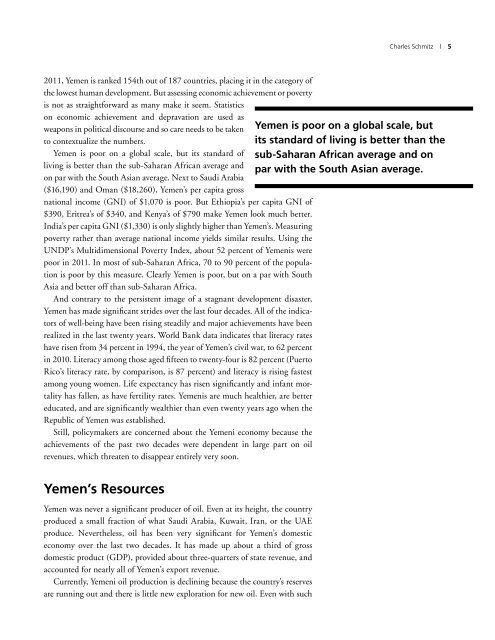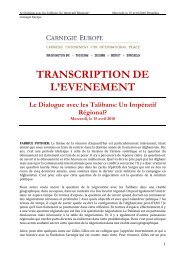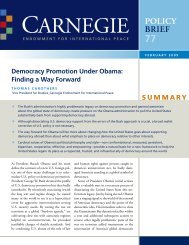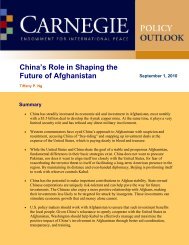building a better yemen - Carnegie Endowment for International Peace
building a better yemen - Carnegie Endowment for International Peace
building a better yemen - Carnegie Endowment for International Peace
You also want an ePaper? Increase the reach of your titles
YUMPU automatically turns print PDFs into web optimized ePapers that Google loves.
Charles Schmitz | 5<br />
2011, Yemen is ranked 154th out of 187 countries, placing it in the category of<br />
the lowest human development. But assessing economic achievement or poverty<br />
is not as straight<strong>for</strong>ward as many make it seem. Statistics<br />
on economic achievement and depravation are used as<br />
weapons in political discourse and so care needs to be taken Yemen is poor on a global scale, but<br />
to contextualize the numbers.<br />
its standard of living is <strong>better</strong> than the<br />
Yemen is poor on a global scale, but its standard of sub-Saharan African average and on<br />
living is <strong>better</strong> than the sub-Saharan African average and<br />
par with the South Asian average.<br />
on par with the South Asian average. Next to Saudi Arabia<br />
($16,190) and Oman ($18,260), Yemen’s per capita gross<br />
national income (GNI) of $1,070 is poor. But Ethiopia’s per capita GNI of<br />
$390, Eritrea’s of $340, and Kenya’s of $790 make Yemen look much <strong>better</strong>.<br />
India’s per capita GNI ($1,330) is only slightly higher than Yemen’s. Measuring<br />
poverty rather than average national income yields similar results. Using the<br />
UNDP’s Multidimensional Poverty Index, about 52 percent of Yemenis were<br />
poor in 2011. In most of sub-Saharan Africa, 70 to 90 percent of the population<br />
is poor by this measure. Clearly Yemen is poor, but on a par with South<br />
Asia and <strong>better</strong> off than sub-Saharan Africa.<br />
And contrary to the persistent image of a stagnant development disaster,<br />
Yemen has made significant strides over the last four decades. All of the indicators<br />
of well-being have been rising steadily and major achievements have been<br />
realized in the last twenty years. World Bank data indicates that literacy rates<br />
have risen from 34 percent in 1994, the year of Yemen’s civil war, to 62 percent<br />
in 2010. Literacy among those aged fifteen to twenty-four is 82 percent (Puerto<br />
Rico’s literacy rate, by comparison, is 87 percent) and literacy is rising fastest<br />
among young women. Life expectancy has risen significantly and infant mortality<br />
has fallen, as have fertility rates. Yemenis are much healthier, are <strong>better</strong><br />
educated, and are significantly wealthier than even twenty years ago when the<br />
Republic of Yemen was established.<br />
Still, policymakers are concerned about the Yemeni economy because the<br />
achievements of the past two decades were dependent in large part on oil<br />
revenues, which threaten to disappear entirely very soon.<br />
Yemen’s Resources<br />
Yemen was never a significant producer of oil. Even at its height, the country<br />
produced a small fraction of what Saudi Arabia, Kuwait, Iran, or the UAE<br />
produce. Nevertheless, oil has been very significant <strong>for</strong> Yemen’s domestic<br />
economy over the last two decades. It has made up about a third of gross<br />
domestic product (GDP), provided about three-quarters of state revenue, and<br />
accounted <strong>for</strong> nearly all of Yemen’s export revenue.<br />
Currently, Yemeni oil production is declining because the country’s reserves<br />
are running out and there is little new exploration <strong>for</strong> new oil. Even with such

















